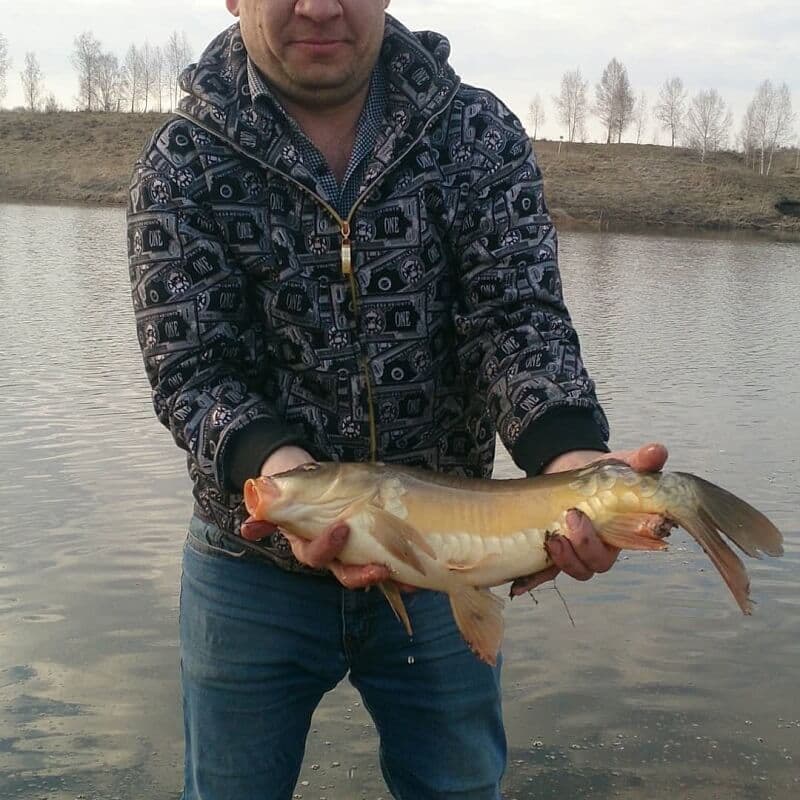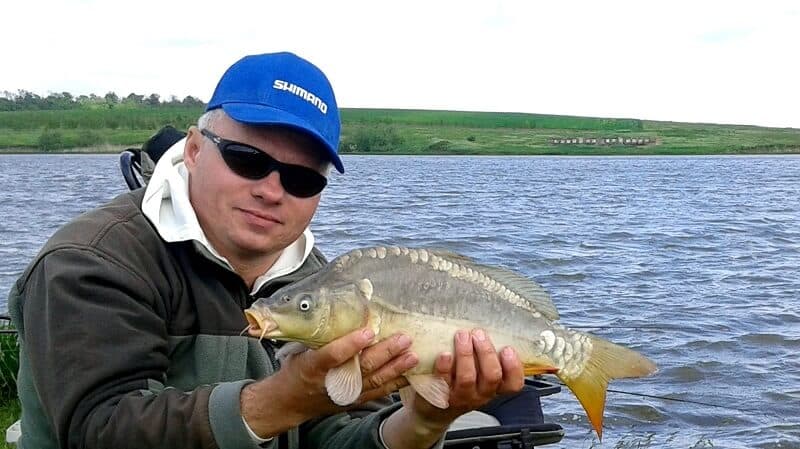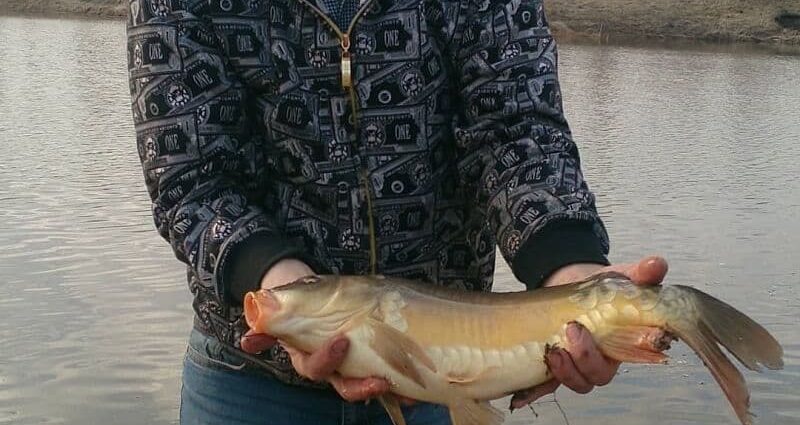Contents
Carp is a coveted trophy for any angler. It grows quickly and reaches an impressive size, and when playing it has strong resistance, for which anglers love it. They catch it mainly on paid ponds, of which there have been a lot lately. But even despite the fact that the reservoirs are paid, it is far from a fact that it will be possible to leave with a full fish tank. Carp fishing on the pond also has its own subtleties and nuances. Catching carp on the pond has its own nuances, which will be discussed in this article.
Biting carp at different times of the year
The deadest season in carp fishing is winter. At this time, he mostly stands in the deep parts of the reservoir and only occasionally feeds.
In spring, it enters shallow areas, where the water warms up the fastest and begins to feed before spawning.
Well, the best season for carp fishing on the pond starts from the end of May and ends in September. With the beginning of summer, the carp moves throughout the reservoir, often it can be found in the deep parts of the reservoir. His favorite habitats are snags, pits, brows, shell rock, bushes and trees hanging over the water, and reeds.
In autumn, with the cooling of the water and the death of vegetation, the carp goes to the deepest parts of the reservoir, where they gather in large flocks and gain weight before freezing.
What do carp bite
Although the carp is called the “underwater pig” for its voracity, it is still quite picky in the choice of food. Not even picky, but cautious, as it has a very strong sense of smell. Therefore, you can not catch him on any bait. One of the main rules when fishing for carp is to take as many different baits as possible with you. This fish is omnivorous and is caught on all types of baits that only white fish can be caught on:
- Animal bait: worm, dough, bloodworm. Carp bite well on these baits in any season, but especially well in spring and autumn.
- Vegetable baits are the most popular for catching carp in the summer on the pond. These include: corn, pearl barley, peas, various cereals, mastyrka, bread. Boilies can also be included in this category. Also in the southern regions, carp fishing on a bottom rod is popular, where cake is used as bait.
- Boilies. One of the most popular baits for carp fishing. There are different tastes, smells and sizes. Some anglers prefer to make their own boilies rather than buying them from the store.

The most important aspect is the choice and preparation of bait. It seems that catching carp on a paid pond seems simple, because the reservoir is stocked with fish and, in theory, the bite should be good. But this is not always the case. There is a lot of fishing pressure on the pay ponds, fishermen throw huge amounts of bait into the water and carp have a lot to choose from.
Carp like to eat a lot and are very responsive to smells. Therefore, in the composition of the bait should be a lot of aromatics. So much so that this amount is not required when catching other white fish. Therefore, it is quite difficult to go too far with aromatics when fishing for carp. Especially attractive for large specimens are fruity smells.
In addition to strong aromatics, the bait must contain large components – corn, pellets, chopped worm, maggots, various cereals, chopped or whole boilies.
How to choose a promising place
The choice of a promising fishing point is no less important element in carp fishing than bait. Carp does not stand anywhere in the pond, but tries to keep to certain paths and runs along proven routes. Of course, if the fish is active, then it can be caught without knowing the bottom topography. In the event that the reservoir has little vegetation, then the carp stands in deep and flat areas.
Do not be lazy and study the place well before fishing. Promising places cannot be seen from the surface of the reservoir. The channel, the transition from one type of bottom to another (for example, from sandy to muddy or vice versa), shell rock – all this is hidden under water. The most accessible way to explore the terrain at the fishing point is to punch the bottom with a marker weight. More expensive – with the help of an echo sounder.
Catching carp on the feeder
Feeder fishing for carp requires patience and perseverance. Therefore, you should not wait for bites every five minutes, as is the case when catching roach or other white fish.
Tackle for catching carp on the feeder:
- A rod with a length of 2.7 – 4.2 meters and a test from 40 to 100 grams. Long rods are needed in cases where it is necessary to make a very long cast (80-100 meters). For fishing at close and medium distances, short rods are quite suitable. As for the rod test, it all depends on the size of the feeder and the casting distance.
- Coil size 3000-4000. It must have a good friction brake. The carp strongly resists and a well-adjusted brake will help to avoid annoying landings when playing.
- Monofilament line. The main one is 0.20 – 0.25 mm in diameter. Leash – 0.14-0.20 mm. Thin fishing lines are best used only for capricious biting. The length of the leash is from 20 to 80 cm. Braided fishing line can also be used as the main one, but due to the fact that it does not have a “memory”, more frequent gatherings of fish are possible.
- Thick wire hooks. Size – 12-6 according to international numbering. The size of the hook depends on the bite of the fish. With active biting, you can put large hooks, with capricious – smaller ones. Hooks must be made of thick wire only. It is not difficult to straighten thin hooks even for medium-sized carp. When fishing for corn, bronze-colored hooks are well caught, as they match the color of the bait.
Having clipped the fishing line, be sure to count the turns of the reel. This will help you find a feeding point in the event of a break in gear. Although many anglers do not recommend clipping the line, as it will be problematic to remove it when biting. Instead of a clip, it is better to mark the fishing line with a bright marker or put an elastic band.
The most popular feeder equipment for carp fishing is the paternoster. With a capricious bite, you should reduce the diameter of the leash and the size of the hook.
Carp tackle fishing
Carp fishing is not just fishing, but a whole philosophy. Its essence can be formulated in one sentence – respect for nature. Therefore, the principle of “caught and release” is dominant in such fishing. Carp fishers are focused not on the quantity of fish, but on its quality. those. the weight of the trophy is important to them.
Particular attention should be paid to the choice of fishing location, since fishing often takes several days and an incorrectly chosen place can ruin the whole fishing.
A large number of gear is another attribute of the carp fisher. Their kit certainly includes the following gear:
- Rods with a length of 3.2 to 4.2 meters, medium action and with a test of 100 to 200 grams. As in the case of feeder rods, the length depends on the fishing distance. The medium action is the best for carp fishing, as it dampens fish jerks better than fast action rods and has better range compared to slow action rods. To measure the bottom, carp anglers use a marker rod. It has a high sensitivity, thanks to which all the unevenness of the bottom is well tracked.
- Feeders type method. Unlike feeder fishing, where net feeders are more often used, open feeders are used here.
- Monofilament fishing line with a diameter of 0.30 – 0.50 mm.
- Thick wire hooks.
- Rod pod or rod stand. You can attach 2-4 rods to such a stand. It is equipped with electronic and mechanical bite alarms.
- Electronic bite alarms. Very handy thing when catching carp. The sound signal can be adjusted in different tones. This is very convenient, because by the sound you can determine on which rod a bite occurred.
- Powerful carp reels. Such reels have a large line-intensive spool (for example, 300 meters of fishing line with a diameter of 0.30 mm can be wound on it) and are equipped with a baitrunner function (thanks to it, carp will not be able to drag the rod into the water).
- Big pod. Since the main task is to catch a trophy carp, the size of the landing net should match the fish.
Particularly advanced carp anglers feed the place using a radio controlled boat. With it, you can, without spending a lot of effort, lure any point on the pond. You can also bring not only bait, but also equipment.
The most popular nozzle for such fishing is boilies. They are attached with a hair rig. Hair montage is specially designed so as not to injure the lips of the carp. Since the hook is at a distance from the bait, the carp will not be able to deepthroat the bait. In addition, it is notched behind the lower lip, where it has few nerve endings.
Carp fishing with a float rod
Fishing for carp with a float rod on the pond is also a very interesting activity. Often carp stands far from the shore, where they feel safe. Therefore, it is better to use match rods. They allow you to cast the equipment over considerable distances, unlike the Bologna tackle.
There are subtleties in float fishing for carp:
- For fishing, it is better to use a monofilament line, as it has extensibility and better dampens carp jerks when playing. This allows you to pull fish of almost any size.
- In order to fish at long distances, a sliding rig is needed.
- Starter feed should be very large. It is necessary to throw 15-20 balls of bait at the fishing point. This is done in order to attract the main flock and subsequently not to frighten it with frequent bait casting. You need to feed the fish pointwise using a slingshot.
- When playing a large carp, do not hold the rod vertically, lower it to the water. Also, do not keep the rod in line with the line, otherwise the fish may break loose.
- If the reservoir has a flat bottom, without any holes and shelters, then the carp usually moves to the shore and feeds near the reeds. But the closer to the shore, the carp becomes more shy, he is afraid of any noise and takes the bait very carefully.

Equipment for float fishing for carp:
- Match rod with a test up to 30 grams and a length of 3.60-4.20 meters. Main line 0.2 – 0.25 mm. Leash – 0.15-0.20 mm.
- Spinning reel with match spool. Such a spool has a small side, which allows you to make long casts with a thin line.
- Sliding float. Wagler-type floats with additional weight are especially good.
- Thick wire hooks. Size 12 – 8 according to international numbering.










